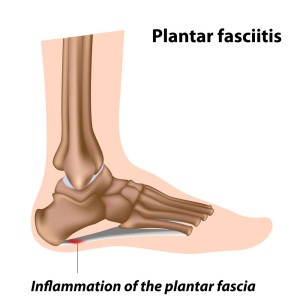In the first place, plantar fasciitis is one of the causes of heel pain. Deep inside the sole of the foot there is a flat sheet of connective tissue with the name of “plantar fascia”. With this in mind, The fascia keeps the forefoot and the heel together. On the other hand, with prolonged standing the plantar fascia can get inflamed and degenerative changes can take place close to the insertion of the plantar fascia near the heel bone, which is called plantar fasciitis.
In other words, this leads to heel and foot pain and discomfort. To clarify, this is usually associated with a heel cord contracture. At night the foot is usually plantar flexed (toe pointed downwards) and this aggravates the heel cord contracture. When the toes are bent upwards (dorsiflexed), the pain of plantar’s fasciitis is worsened. It is important to realize that this is one of the diagnostic signs.
Another key point is that there is no connection between flat foot and plantar’s fasciitis. They are independent conditions. Plantar fasciitis treatment consists of stretching exercises of the heel cord to improve postural factors. The patient with plantar fasciitis has to avoid repetitive loading stress of the foot. In addition the patient must avoid activities such as running or prolonged standing. Plantar fasciitis shoes and plantar fasciitis night splints might help. Surgery for plantar fasciitis is not that successful. Only 5% of cases get better with surgery. The surgical procedure consists of a plantar fascia release. Orthotics can be useful by redistributing some of the forces from the plantar fascia (Ref.3). This helps with heel pain and foot heel pain in cases of plantar fasciitis.
References
1. ABC of rheumatology, second edition, edited by Michael L. Snaith , M.D., BMJ Books, 1999. Chapter 5.
2. The Merck Manual, 7th edition, by M. H. Beers et al., Whitehouse Station, N.J., 1999. Chapter 270.
3. Wheeless’ Textbook of Orthopaedics: http://www.wheelessonline.com/ortho/arthritis
4. The Merck Manual, 7th edition, by M. H. Beers et al., Whitehouse Station, N.J., 1999. Chapter 60, p.487.
5. Goldman: Cecil Textbook of Medicine, 21st ed.(©2000)W.B.Saunders
6. Ferri: Ferri’s Clinical Advisor: Instant Diagnosis and Treatment, 2004 ed., Copyright © 2004 Mosby, Inc.
7. Rakel: Conn’s Current Therapy 2004, 56th ed., Copyright © 2004 Elsevier
8. Suzanne Somers: “Breakthrough” Eight Steps to Wellness– Life-altering Secrets from Today’s Cutting-edge Doctors”, Crown Publishers, 2008







